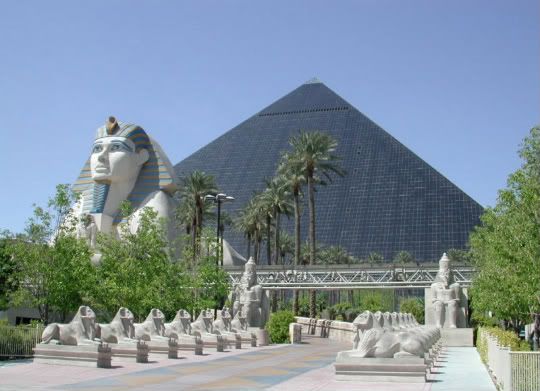☆ 005 ; at the other end of the timeline
While a person dies every day during the eight or more hours in which he or she functions as a commodity, individuals come to life afterward in their spiritual creations. But this remedy bears the germs of the same sickness: that of a solitary being seeking harmony with the world.
Che Guevara

What I am zooming in on here, ladies and gentlemen, that little black square in the middle of nowhere, is the Luxor casino and hotel in Las Vegas. I recently took a trip there back in mid-January and was completely perplexed; Las Vegas sells place like no other. They have a term for this, much to my excitement!-- cultural commodification, which really means if they can pack it and sell it they will. I couldn't buy into it, my delight was on a much more intellectual level, but I can see why this dusty city in the middle of the desert [as soon as you leave the city limits there is literally nothing in all directions] appeals to people worldwide: you get your Paris, Brazil, Egypt, New York [and everywhere in between] vacations all rolled into one! And there's lots of free alcohol!

Cultural commodification is definitely a product of postmodernism. I struggle with postmodernism a lot, whether or not it's valid, but then again, I would think economic value outranks cultural significance. Or are tied together, as it is in Las Vegas. That's why the Luxor is the perfect example of this tongue-in-cheek design phenomenon-- the parallels are too obvious, but so overstated as to come off playfully. Both are located in desert environments. The top of the pyramid has great design significance [in Egypt they could be capped with gold, in Las Vegas a column of light is emitted from it at night]. Great treasures were stored in the pyramids of Egypt, great treasures can be made in the pyramid of Las Vegas. Plus I'm amused that the exhibit I saw in that particular casino was this one. How appropriate.
This only scratches the surface of the greater question of cultural commodification and postmodernism. Is it a valid way to design? I mean, drawing upon the past is certainly necessary, you need some context, but is this too extreme? Can it be appreciated in the same way Neoclassical buildings can be?
What is clear now is that the West's fascination with the primitive has to do with its own crises in identity, with its own need to clearly demarcate subject and object even while flirting with other ways of experiencing the universe.
Mariana Torgovnick
What would buildings like these suggest is our identity? I think it's like holding up a giant mirror but not being able to recognize the reflection. And that maybe, secretly, all buildings commodify something else, but they don't want to admit it. It's all in the design language-- the design language of Las Vegas is mutually intelligible with the places that it commodifies, but they certainly don't have the same cultural significance. I think by designing places such as the Luxor claims a history as our own, though, perhaps as a reaction to the banalities of mechanical thought and design? Anyone can stay in a hotel, but why stay there when you can stay in a pyramid!
These are our modern hieroglyphs.
I better stop writing, I don't want to sound like a Marxist!


0 Comments:
Post a Comment
Subscribe to Post Comments [Atom]
<< Home